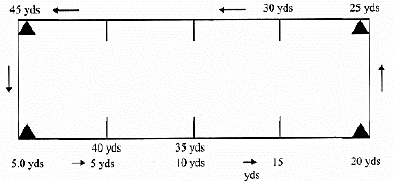Key Points:
- Computation of Fat Percentage - Slaughter – Lohman Children Skinfold Formula Specification
- Measurement of Muscular strength - Kraus-Weber test
- Motor Fitness Test - AAPHER
- General Motor Fitness - Barrow three item general motor ability
- Measurement of Cardio - Vascular Fitness-Harvard Step Test/Rock Port Test
- Measurement of flexibility - Sit & Reach Test
- Rikli & Jones Senior Citizen Fitness Test
Computation of Fat Percentage
The Body Fat Percentage Calculator uses the U.S. Navy fitness formula to calculate an estimation of body fat. Although the water displacement test is the most accurate way to determine body fat percent, however the Navy Body Fat test or YMCA formula is sufficiently accurate within 1-3% for most people.
Body fats include essential body fat along with storage body fat.
The essential body fat is required in order to maintain life and reproductive organ functions. The percentage of essential body fat in women is greater than that found in men, mainly because of childbearing demands and other hormonal functions.
The percentage of essential fat is 3% to 5% in men, and 8% up to 12% in women.
Storage body fat consists of fat accumulation in adipose tissue, which is meant to protect the internal organs (chest and abdomen). The minimum recommended total body fat percentage exceeds the essential fat percentage value mentioned above.
Slaughter – Lohman Children Skinfold Formula Specification
This description is specifically for the SKYNDEX SYSTEM I programed with the SlaughterLohman formula. The Slaughter-Lohman is named after the authors of the original research study. Each formula was developed from the results of underwater weighing and skinfold data taken from several hundred individuals over a wide range of age, body structure, body composition and exercise habits. The skinfold equations shown below are used to predict body fat in children 6-17 years of age:
TRICEPS
Measure vertically on back of arms midway between top of shoulder point (Acromial Process) and elbow (Olecranon Process)
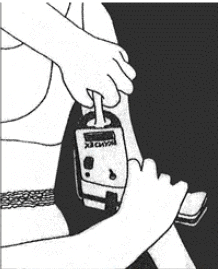
CALF
Inside (medial) of the right lower leg at the greatest calf girth.
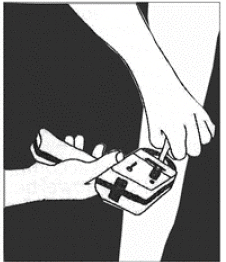
Dial Position 1 on Slaughter-Lohman Skyndex I Caliper
(OR 11 if multi-formula unit)
Boys: % Body Fat = 0.735 (Triceps + Calf) + 1.0
Dial Position 2 on Slaughter-Lohman Skyndex I Caliper
(OR 12 if multi-formula unit)
Girls: % Body Fat = 0.610 (Triceps + Calf) + 5.1
Muscular strength is the amount of force a muscle or a group of muscles can exert against resistance for short duration as in aerobic activities
Kraus Weber Test
It is a test of minimum muscular fitness of the various muscles of the body.
The test consists of six items which indicate the level of muscular strength and flexibility of key muscle groups. Usually the scoring of each item is graded either on pass/fail basis or a range of scoring from zero to ten. A subject's grade of zero means that the subject has failed a particular test item; score ranges from one to ten are for subjects who pass these test items. The six tests are
Test 1 tests the strength of the abdominal and poses muscles.
Test 2 tests the strength of the abdominal muscles.
Test 3 tests the strength of the poses muscles.
Test 4 tests the strength of the upper back.
Test 5 tests the strength of the lower back.
Test 6 tests the strength of the back and hamstring muscles.
AAHPER Test
The AAHPER (American Alliance for Health, Physical Education and Recreation) youth fitness test was formed in 1965 in United States, but was revised in 1976. This test was administered on school students of 17 years of age.
This test consists of the following six items:
a. Pull ups: In case of girls, the pull-ups are to be started from a flexed arm hang. This test item judges the arm and shoulder girdle strength.
b. Flexed Leg sit-ups: This test is meant to judge the efficiency of abdominal and hip flexor muscles.
c. Shuttle Run: This test item is meant for judging the speed and change of direction.
d. Standing Long Jump: For judging the explosive power of leg muscles.
e. 50 yard Dash or Sprint: For judging speed.
f. 600 yard Run: For judging endurance.
Administration of Tests: these tests can be conducted in a gymnasium or out-doors. The only apparatus required in these tests is a horizontal bar having a diameter of approximately 1½ inches for pull-ups and flexed arm hang for girls. However, arrangement has to be made for the timing and recording of all scores with the help of timers and recorders.
Item No.1—Pull ups: This item has to be done from a hanging position on the bar by using the overhead grasp (with palms facing outwards). The arms and legs of a subject should be fully extended. Form hanging position, the subject should raise his body with his arms until his chin is placed over the bar. Then, he should lower his body to a full hanging position. In doing so, the knees should not be bent and the pull should not be jerky or snap pull. (The number of completed pull-ups is the score of the subject.)
Item No. 1 (Girls)—Flexed-arms hung: In this test item for girls, the subject is required to hang from the bar with flexed arms and overhead grasp. She should raise her body to a position where the chin is above the bar, the elbows are flexed and the chest is close to the bar. The stopwatch is started as soon as a subject assumes such a hanging position and is stopped when the subject‘s chin falls below the level of the bar. (The time recorded in seconds for which a subject holds the hang position is her score)
Item No. 2—Sit-ups: For this test meant for boys and girls, the subject should lie on his or her back with knees flexed and kept not more than 12 inches from the buttocks. The hands of the subject should be placed at the back of the neck, fingers clasped and elbows touching the mat. From this position, the subject should raise his or her head and elbows forward upwards till the elbows touch the knees. This constitutes one sit-up. (The number of correctly performed sit-ups in 60 seconds from the start of the first sit-up is the score of a subject).
Item No. 3—Shuttle Run: For this test item, two parallel lines are drawn at a distance of 30 feet from each other and two blocks of wood are placed behind one of the lines. The subject has to stand behind the other line and on the signal ―Ready‖, ―Go‖ should run to pick up one block, run back to the starting line and place the block behind the line. He should again turn back to pick up the second block and bring it also behind the starting line. Two such trials are given. (The better time of the two trials to the nearest 10th of a second is the score of the subject).
Item No. 4—Standing Long Jump: In this test, a subject is required to stand behind a take-off line, with feet apart. He takes a jump forward by extending his bent knees and swinging the arms forward. The best jump recorded, out of the three trials given, is the score of the subject. (The jump should be recorded in feet and inches).
Item No. 5—50 Yard Dash: Two lines are drawn at a distance of 50 yards from each other. The subject is made to run from the starting line to the finish line and his time taken is recorded in seconds (nearest to the tenth of a second.) This indicates his score.
Item No. 6—600 Yard Run: This run can be organized on a track, on a football field or an open area marked for this purpose. In this test item, a subject runs a distance of 600 yards. The subject takes a standing start from the start line. The subject may walk in between. However, the objective is to cover the distance in the shortest time. When he crosses the finish line, he is informed of his time. (The time taken to run the distance is recorded in minutes and seconds).
The Aapher—Youth Physical Tests were created in 1957. During the years 1957- 58 these tests were applied to 8500 School Children of classes 5 to 8 in the United States of America. On the basis of this study standard rooms were created. Studies were conducted on 2200 College level students in 1960 and percentile rooms were created, Similarly Percentile rooms were created on the basis of studies belonging to 50 institutions. New percentile rooms were created again in 1965 on the basis of age. This study included 9200 boys and girls in the 10 to 17 years age group.
1. Pull Ups Boys is an activity meant only for boys:
Equipment: A metal or wooden bar approximately 1½ inches in diameter is preferred. A doorway gym bar can be used and if no regular equipment is available, a piece of pipe or even rungs of a ladder can serve the purpose.
Description: The bar should be high enough so that the pupil can hang with his arms and legs fully extended and feet free from the floor. He should use the overhand grasp. After coming in hanging position, the pupil raises his body by his arms until his claim can be placed over the bar. Then he lowers his body to a full hang as in starting position. The exercises is repeated as many times as possible.
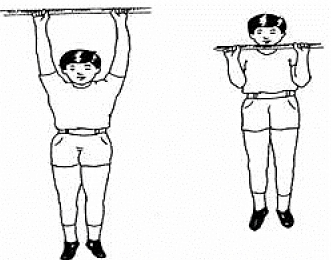
Rules
(i) Each Student will be allowed one trial.
(ii) The body must out swing during the execution of the movement.
(iii) The knees must not be raised and the kicking of legs is not permitted.
Scoring: Record the number of completed Pull Ups.
2. Flexed Arm Hang: This activity is meant only for girls.
Equipment: A horizontal bar is used. The oximeter of the rod ought to be 1½ inches. A stop watch is needed is record time.
Description: The height of the bar should be adjusted so it is approximately equal to the pupil’s standing height. The pupil should use an overhang grasp. With the assistance of two spotters, one in front and one in back of Pupil the Pupil raises her body off the floor to a position where the Chin is above the bar, the elbows are flexed and the Chest is close to the bar. The Pupil holds this position as long as possible.
Rules:
(1) The Stopwatch to started as soon as the Subject takes the hanging position.
(2) The watch is stopped when:
(i) Pupil’s Chin touches the bar
(ii) Pupil’s head hits backward to keep Chin above the bar.
(iii) Pupil’s Chin falls below the level of the bar.
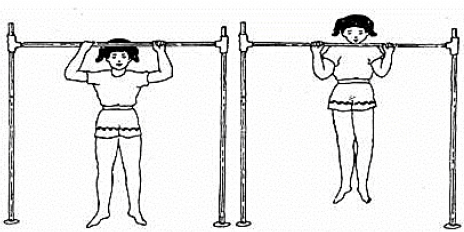
3. Sit-Ups (Flexed Leg), Boys and Girls
Scoring: The length of time the subject holds the hanging position will be recorded in seconds. Sit-ups (flexed leg)
Equipment: Clean floor, Mat or Dry Turf and Stop-Watch.
Description: The Pupil lies on his back with his knees bent, feet on the floor and heels not more than 12 inches from the buttocks. The angle at the knees should be less than go degrees. The Pupil puts his hands in the back of his neck with fingers clasped and places his elbows squarely on the mat, floor and turf. His feet are held by his partner to keep them in touch with surface. The Pupil heightens his abdominal muscles and brings his head to knees. This action constitutes one sit up. The number of correctly extended Sit ups performed in 60 seconds shall be the score.
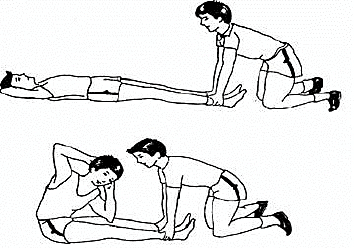
Rules:
(1) No rectory is permitted between sit ups.
(2) Keep the fingers clasped behind his neck.
(a) Keep the fingers clasped behind his neck.
(b) Bring both elbows forward in starting to sit up without pushing off the floor with an elbow.
(c) Return to starting position with elbows flat on the surface before sitting up again.
Scoring: Only the Sit ups a pupil is able to do in 60 Seconds are recorded.
4. Shuttle Run (Boys and Girls):
Equipment: Two blocks of wood, 2 inches x 2 inches x 4 inches and a stopwatch. Pupils must wear sneakers or run barefoot.
Description: Two parallel lines are marked on the floor 30 feet apart. The width of a regulation Volleyball Court serves as a suitable area. Place the blocks of wood behind one of the lines.
The pupil starts from behind one of the lines. On the signal “Ready” or “Go” the pupils runs to the blocks, picks one up runs back to the starting line and places the block behind the line. He then runs back and picks up the second block which he carries back across the Starting Line.
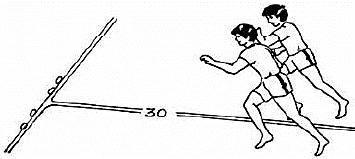
Rules: Allow two trials with some rest between. Scoring: Record the time of the better of the two trials.
5. Standing Broad (Long) Jump:
Equipment: Mat, Floor or Outdoor Jumping pit and Tape Measure.
Description: Pupil stands with the feet several inches apart and the toes just behind the take offline. Preparatory to jumping, the pupil swings the arms backward and bends the knees. The jump is accomplished by simultaneously get bending the knees and swinging forward the arms.
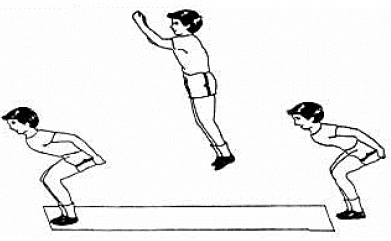
Rules:
(1) Allow three trials.
(2) Measure from the take off line to the feet or other parts of the body that touches the floor nearest the take off line.
Scoring: Record the best of the three trials.
6. 50 Yards Run (Boys and Girls):
Equipment: Two stopwatches or one with a split second times.
Description: It is preferable to administer this test to two pupils at a time. The starter will use the commands: “Ready” and “Go” the race comes to an end at the “Finishing Line”, Rules, the stop watch is kept on from the word “Go” to the finishing line, a time is recorded to the one tenth of a second.

7. Soft-Ball Throw (Boys and Girls):
Equipment: Soft Ball 12, Measure Tape.
Description: Game is played in a football field on a field of similar size. Lines are drawn at a distance of five yards each. The pupil who throws the ball can throw from a distance of 6 feet.
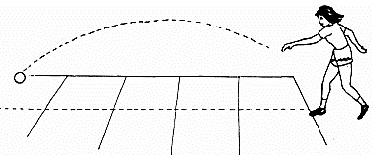
Rules:
(1) It is necessary to have the ball in one hand.
(2) Three chances are given to each player.
Scoring: Best of the three throws is counted.
8. 600 Yards Run or Walk (Boys and Girls)
Equipment:
1. A Track
2. A Stopwatch
Description: Pupils take their positions at the standing start. The race starts with command words: “Ready” and “Go”. As many as Six Pupils can participate at a time.
Rules: Walking is permitted but the object is to cover the distance in the shortest possible time.
Scoring: Record in Minutes and Seconds.
General Motor Fitness- Barrow three-item general motor ability
General Motor Fitness: Barrow three items for general motor ability (Standing Broad Jump, Zig Zag Run & Medicine Ball Put- For boys: 03 KG & for Girls: 01 KG) Harold M Barrow developed a test of motor ability for college men as well as for high school boys. The test battery comprised of three items which are explained below:
(1) Standing Broad Jump
Purpose of the Test: To measure Power mainly but also agility, speed and strength. Facilities and Equipment required: One 5 x 12 feet mat marked with take off line and parallel lines 2 inches apart as shown in the diagram.
Directions: The subject is advised to stand just behind the take off line with feet together. Then by giving swing of arms and bending knees a jump is taken. Landing is done keeping feet together.
Instructions: The subject must crouch before jump. Before the jump is taken the arms are swung. Three trials are given.
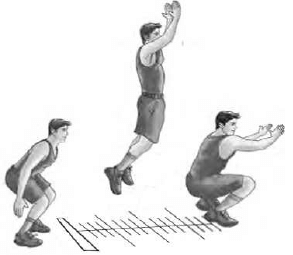
Scoring: The final score is the distance in inches from the best jump.
Table-Standing Broad Jump (T-Scores For High-School and junior High-School Boys)


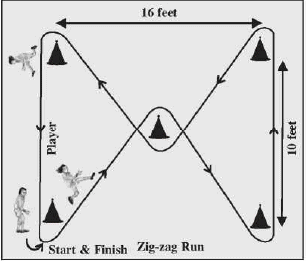
(2) Zigzag Run
Purpose of the Test: To measure agility mainly but also speed.
Facilities and Equipment required: One stop watch & 5 flags or cones as shown in the diagram given below.
Directions: First of all demonstration is given. The subject is advised to stand just behind the starting line. Then running is done in zigzag manner and three rounds are completed.
Instructions: The subject can take start from standing position. After the start running is done in a manner of figure eight. Like this three circuits are completed.
Scoring: The final score is the time in seconds for three laps.
Table-Zigzag Run (T-Scores for High-School and Junior High-School Boys)

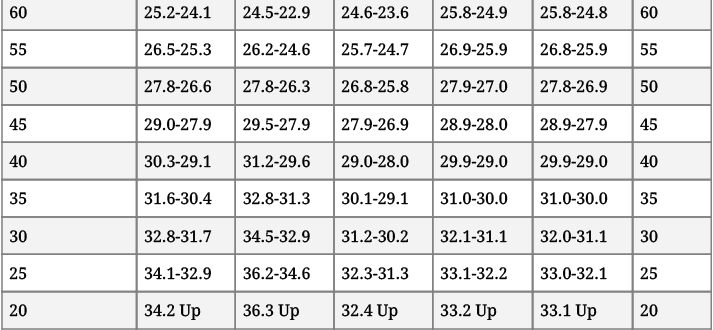
(3) Six Pound Medicine Ball Put
Purpose of the Test: To measure mainly strength of arm and shoulder girdle but also to measure power of arm and shoulder girdle coordination, speed and balance. Facilities and Equipment required: A space in the gymnasium hall with 90 x 25 feet. A 15 feet restraining line marked. One medicine ball weighing six pounds and one measuring tape.
Directions: First of all event is explained and the demonstration is given. The subject is advised to put the ball but no throwing is not allowed. Three trials are given. But if the subject commits three faults then he must put until he makes a fair put.
Instructions: The subject must take the position before the restraining line. No overstepping is allowed after restraining line. The medicine ball is put not thrown.
Scoring: The final score is the distance of the best put in the nearest foot.
Table-Medicine Ball Put (T-Scores for High-School and Junior High-School Boys)

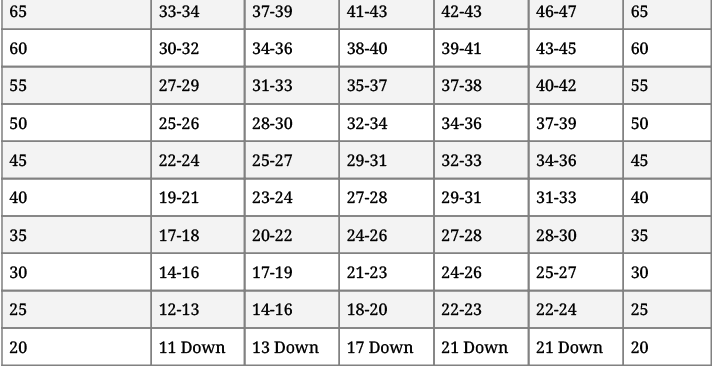
7.4 Measurement of Cardio- Vascular Fitness-Harvard Step Test/Rockport Test
Cardiovascular fitness is the ability of an individual to strengthen the heart muscles during continuous muscular activities in which numbers of muscles groups are used.
1. Harvard Step Test-Aerobic Fitness (Recovery time)
100*(Total test time in seconds (the time for which the athlete was able to do the stepping up and down)
2*(the total number of heartbeats for all the three time intervals)
2. Rockport Fitness Test-One mile Walking test
VO2max = 132.853 - (0.0769*Weight) - (0.3877*Age) + (6.315*gender) - (3.2649*time) -(0.1565*Heart Rate)
Harvard step test- This test requires the athlete to step up and down off a gym bench for 5 minutes at a rate 30 steps/minute which measures the Aerobic fitness test. The distance to be covered is 1 mile on normal track. After the workout, timing, heart rate, has to be measured. The athlete steps up and down onto a standard gym bench once every two seconds for five minutes (150 steps), The assistant stops the test after 5 minutes The assistant measures the athlete's heart rate (bpm) one minute after finishing the test -Pulse1 The assistant measures the athlete's heart rate (bpm) two minutes after finishing the test - Pulse2 The assistant measures the athlete's heart rate (bpm) three minutes after finishing the test - Pulse3 b. Rock fort one mile test- Main objective to check the development of vo2 max.
Harvard step test fitness index score

In the Harvard step test for cardiovascular fitness, the physical efficiency index PEI=(Duration or exercise in seconds x 100) divided by 2× Sum of pulse counts in recovery
Rockport fitness walking test
Administration of Test:
(i) Choose a windless day to conduct the test.
(ii) Record your weight in pounds (lbs)
(iii) Walk one mile (1609 mt) as fast as possible.
(iv) Record the time to complete the one mile walk.
(v) Immediately on finishing the walk record your heart rate (beats per minute).
(vi) Determine your Maximum Cardio-Respiratory ability (VO2) from the calculation given below
Calculation Procedure: An Analysis of the result is done by comparing it with the result of previous test. It is expected that, appropriate training between each test should be done to show improvement.
The formula used to calculate
VO2 Max is : 132·853 – (0·0769 × weight) – (0·3877 × Age) + (6·315 × Gender) – (3·2649 × Time) – (0·1565 × Heart rate)
Where:-
(a) Weight is in pounds (lbs),
(b) Gender : Male = 1 and Female = 0
(c) Time is expressed in minutes and seconds,
(d) Heart rate is in beats/minute
(e) Age in years.
Rikli and jones senior citizen fitness test
The Rikli and Jones Senior Citizen Fitness Test for assessing the functional fitness of older adults describes easy to understand and effective tests to measure aerobic fitness, strength and flexibility using minimal and inexpensive equipment. The Individual fitness test items involve common activities such as getting up from a chair, walking, lifting, bending and stretching.
The tests were developed to be safe and enjoyable for older adults while still meeting scientific standards for reliability and validity. The tests are
(i) Chair Stand Test-testing lower body strength
(ii) Arm Curl Test-testing upper body strength
(iii) Chair sit and Reach Test-lower body flexibility test
(iv) Back Scratch Test-upper body flexibility test
(V) 8 Foot Up and Go Test-agility test
(vi) Walk Test (6 min) or Step in Place Test (2 min)-The V, falk Test is used to assess aerobic fitness ;
however, if the person uses orthopedic devices when walking or has difficulty balancing,
they do the Step in Place Test.
Fitness Index F.I.
The Arm Curl Test is a test of upper body strength. The purpose of this test is to measure upper body strength and endurance. The subject has to do as many arms curls as possible in 30 sec. This test is conducted on the dominant arm side (or stronger side), the procedure is
i. The subject sits on the chair holding the weight (8 pounds for men / 5 pounds for women) in the hand using a suitcase grip (palms facing towards the body) with the arm in a vertically down position beside the chair.
ii. The upper arm is placed against the body so that only the lower arm is moving (the tester may assist to hold the upper arm steady).
iii. The subject curls the arm up through a full range of motion, gradually turning the palm up (flexion with suspiration).
iv. Then the arm is lowered through the full range of motion, gradually return to the starting position. The arm must be fully bent and then fully straightened at the elbow.
v. Repeat this action as many times as possible within 30 sec.
vi. score is the total number of controlled arm curls performed in 30 sec.
The sit and reach test is a common measure of flexibility, and specifically measures the flexibility of the lower back and hamstring muscles. This test is important because tightness in this area is implicated in lumbar lordosis, and lower back pain. This test was first described by Wells and Dillon (1952) and is now widely used as a general test of flexibility.
7.5 Measurement of flexibility-Sit & Reach Test
1. Test for absolute flexibility
2. Test of Relative flexibility
a. Measure of linear flexibility test
b. Rotary (Angular measure flexibility test)
I. Sit and Reach Test: This test is used to measure the flexibility of the back and leg (hamstring muscle) It is a kind of absolute and linear test of flexibility.
Equipment: A testing box or a flex measure and a yardstick.
Procedure: The subject is asked to remove shoes and place his/her feet against the testing box while sitting on the floor with straight knees. Now the subject is asked to place one hand on top of the other so that the middle finger of both hands are together at the same length. The subject is instructed to lean forward and place his/her hands over the measuring scale lying on the top of the box with its 10-inch mark coinciding with the front edge of the testing box. Then, the subject is asked to slide his/her hands along the measuring scale as far as possible without bouncing and to hold the farthest position for at least one second.
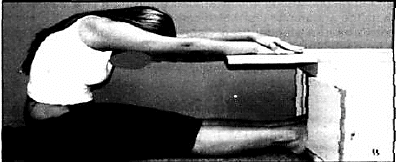
Score: Each subject is given three trials and the highest score nearest to an inch is recorded and 10 inches are subtracted from the recorded reading to obtain the flexibility score which is compared with the standards given in.
Table source: Based on personal experience.
Validity: This test only measures the flexibility of the lower back and hamstrings, and is a valid measure of this.
Reliability: The reliability of this test will depend on the amount of warm-up that is allowed, and whether the same procedures are followed each time the test is conducted. Most sit and reach test norms are based on no previous warm-up, though the best results will be achieved after a warm up or if the test is proceded by a test such as the endurance test which can act as a warm up. If a warm up is used, it is important to have a standardized warm up and test order and repeat the same conditions for each time the test is conducted.
Advantages: The sit and reach test is a common test of flexibility, and is an easy and quick test to perform. If using the standard testing procedure, there is a lot of published data to use for comparison.
Disadvantages: Variations in arm, leg and trunk length can make comparisons between individuals misleading. This test is specific to the range of motion and muscle and joints of the lower back and hamstrings, and may not be relevant to other parts of the body.
Back scratch test
This test is performed in standing position. Keep one hand behind the head and back over the shoulder and reach as far as possible down middle of your back. Your palm should touch your body and the fingers should be downwards. Then carry other arm behind your back palm facing outward and fingers upward and reach up as far as possible trying to touch or overlap the middle fingers of both hands. Fingers should be aligned. Measure the distance between the tips of fingers. If the finger tips touch then score is zero, if they don't touch measure the distance between fingertips(negative) , if they overlap than by how much (+ score).
Eight-foot up and go test
This test is a coordination and agility test for senior citizens.
Purpose: To assess speed, agility and balance while moving.
Equipment required: A chair with straight back( about 44 cms high) a stopwatch, cone marker, measuring tape, and area without hindrance.
Procedure: Keep chair next to the wall and the marker, 8 feet in front of the chair. The participant starts completely seated, with hands resting on the knees and feet flat on the ground. On the command ‘go’ stopwatch is started and the participant stands and walk (on running at all) as quickly as possible to and around cone and returns to the chair to sit down. Time is noted as he sits down on the chair. Two trials are given to the participant.
Scoring: The best trial is recorded to the nearest 1/10th second.
7.6 Rikli Jones-Senior Citizen Fitness Test
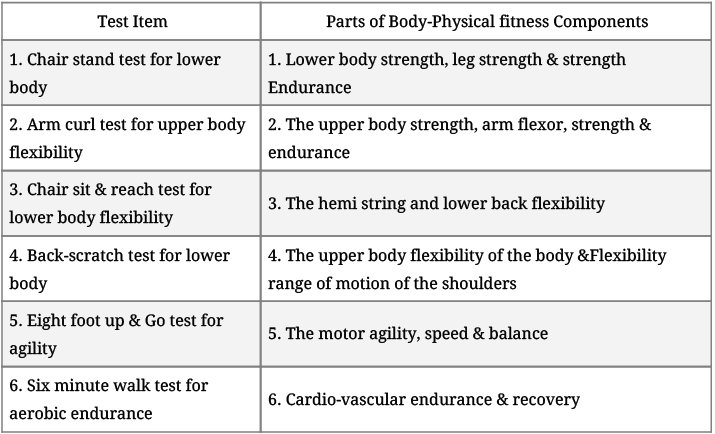
(a) Chair Stand test for lower body strength
Purpose and Daily Benefit: The purpose of the Chair-Stand is to measure the strength of lower body of adults over 60 years of age. Lower body strength is important for activities such as getting out of a chair, on the bus, out of the car, and rising up from a kneeling position in the house or garden. The, strength of your lower body can directly affect the ease with which you perform the activities you do every day.
Equipment: Chair without arms, Stopwatch.
Procedure: Place the chair against a wall where it will be stable. Sit in the middle of the chair with your feet flat on the floor, shoulder-width apart, back straight. Cross your arms at the wrist and place them against your chest. The test partner will tell you when to begin and will time you for 30 seconds, using the stopwatch. You will rise up to a full stand and sit again as many times as you can during the 30-second interval.
(a) Each time you stand during the test be sure you come to a full stand.
(b) When you sit, make sure you sit all the way down. Do not just touch your backside to the chair. You must fully sit between each stand.
(c) Do not push off your thighs, or off the seat of the chair with your hands to help you stand unless you have to.
(d) Keep your arms against your chest crossed and do not allow the arms to swing up as you rise.
(e) If you are on your way up to stand when time is called you will be given credit for that stand.
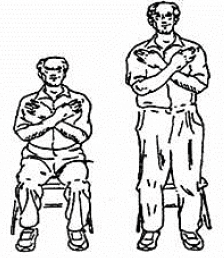
Scoring: The score is the number of completing correct chair stands in 30 minutes.
(b) Arm Curl test for upper body strength Purpose: This test measures upper body strength and endurance.
Equipment Required: 4-pound weight (women, AAHPERD), 5-pound weight (women, SFT), 8 pound weight (for men). A chair without armrests, stopwatch.
Procedure: The aim of this test is to do as many arm curls as possible in 30 seconds. This test is conducted on the dominant arm side (or strongest side). The subject sits on the chair, holding the weight in the hand using a suitcase grip (palms facing towards the body) with the arm in a vertically down position beside the chair. Brace the upper arm against the body so that only the lower arm is moving (tester may assist to hold the upper arm steady). Curl the arm up through a full range of motion, gradually turning the palm up (flexion with supination). As the arm is lowered through the full range of motion, gradually return to the starting position. The arm must be fully bent and then fully straightened at the elbow. The protocol for the AAHPERD test describes the administrator’s hand being placed on the biceps, and the lower arm must touch the tester’s hand for a full bicep curl to be counted. Repeat this action as many times as possible within 30 seconds.
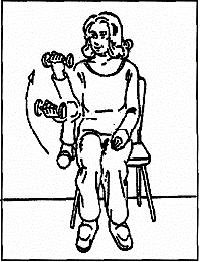
Scoring: The score is given for the total number of controlled arm curls performed in 30 seconds.
(c) Chair Sit and Reach test for Lower Body Flexibility
The Chair Sit and Reach test is a part of the Senior Fitness Test Protocol and is designed to test the functional fitness of seniors. It is a variation of the traditional sit and reach flexibility test.
Purpose: This test measures flexibility of lower body.
Equipment Required: Ruler, straight back or folding chair, (about 17 inches/44 cm high)
Procedure: The subject sits on the edge of a chair (placed against a wall for safety). One foot must remain flat on the floor. The other leg is extended forward with the knee straight, heel on the floor, the ankle bent at 90°. Place one hand on top of the other with tips of the middle fingers even. Instruct the subject to inhale, and then as they exhale, reach forward towards the toes by bending at the hip. Keep the back straight and head up. Avoid bouncing or quick movements, and never stretch to the point of pain. Keep the knee straight, and hold the reach for seconds. The distance is measured between the tip of the Chair sit & reach test for lower body flexibility fingertips and the toes. If the fingertips touch the toes then the score is zero. If they do not touch, measure the distance between the fingers and the toes (a negative score), if they overlap, the measured by how much (a positive score).
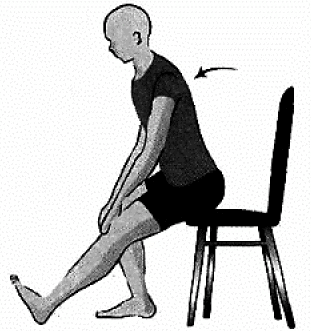
Scoring: Perform two trials. A score is recorded to the nearest inch or 1 cm as the distance reached, either a negative or positive score. Record with leg was used for measurement.
(d) Back Stretch for Upper Body Flexibility
Aim: The Back Scratch Test measure flexibility of your upper body. Upper body’s flexibility affects your ability to reach for items that may be high on a shelf, change a light bulb, or do any activity that requires arm and/or shoulder movement. Maintaining flexibility in your upper body will assist you in continuing to live independently.
Equipment: Ruler
Procedure: Place your left arm straight up in the air above your left shoulder. Bend your left arm at the elbow to reach toward your back, with your fingers extended. Your elbow pointed toward the ceiling. Place your right hand behind your back with your palm out and your fingers extended up. Reach up as far as possible and attempt to touch the fingers of your two hands together. Some people are not able to touch at all, while others fingers may overlap.
Take two practice stretches with each arm, determining which side is more flexible. You will be measuring and recording only your most flexible side. You are now ready to be measured. Perform the stretch as outlined above. Without shifting your hands your test partner will position your fingers so that they are pointing toward each other.

Scoring: The distance between the fingertips of one hand and the other is measured to the nearest half inch or centimeters. If your fingers overlap, the amount of the overlap will be measured. Fingertips just touching receive a score of “0”. If your fingers do not touch, you receive a negative score of the distance between your fingers, measured to the nearest half inch or centimeters.
(e) Eight Foot Up and Go Test for Agility
Aim: The ‘8 Foot Up and Go’ is a coordination and agility test for the elderly, which is a part of the Senior Fitness Test. This test measures speed, agility and balance while moving.
Equipment required: Stopwatch, straight back or folding chair (about 17 inches/44 cm high), one marker, measuring tape, area clear of obstacles.
Procedure: Place a chair next to a wall (for safety) and the marker 8 feet of the chair. Clear the path between the chair and the marker. The subject starts fully seated, hands resting on the knees and feet flat on the ground. On the command, “Go,” timing is started and the subject stands and walks (no running) as quickly as possible (and safely) to and around the cone, returning to the chair to sit down. Timing stops as they sit down.
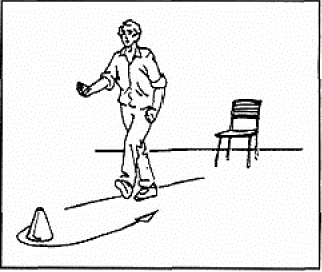
Purpose: To assess aerobic fitness or aerobic endurance which is important for walking distances, stair climbing, shopping and sightseeing etc.
Equipment: Stop watch. * Rectangular ground measuring 20 x 5 yds.
